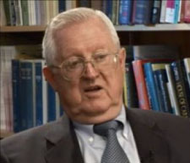This is part of a series remembering and honoring evaluation pioneers in conjunction with Memorial Day in the USA (May 30).
My name is Eleanor Chelimsky and my work has generally involved defining the multiple roles of evaluation, moving it into new areas, and assuring its credibility and utilization in policymaking. I also served as president of AEA, as did Lee Sechrest. My first memory of Lee Sechrest is of meeting him at a long-ago AEA conference. After twenty minutes of conversation, I asked Lee to come and be our Visiting Scholar for the next year at GAO’s Program Evaluation and Methodology Division (PEMD), which I directed.
Pioneering and enduring contributions:
The breadth and depth of his understanding of evaluation methods, his intellectual curiosity, his bent toward innovation, his interest in audiences and in the intelligent dissemination of findings, and his combination of modesty and good humor were all irresistible. I was especially struck by the realism of his views in a period when naiveté (about the ease with which evaluation findings could illuminate public policy) was the norm: he recognized that, although evaluation might not always be of the highest quality, quality might not be the only barrier to use, and he was also one of the first to advocate more evaluative attention to program structure. As he wrote,

“It’s possible that more careful study of programs might show how they could be improved. That is, we might do better to focus more of our efforts on program development rather than simply on evaluation. Most successful societal programs, and there are many things we do quite well, were not created out of thin air as instant successes…….. I think it was Donald Campbell who taught me that we rush to adopt new measures because of our discontent with old ones, not because the new ones have been shown to be better. So it is, I suspect, with social programs.” (Sechrest, 1994, pages 363-364)
Lee was insightful about and willing to help with all parts of a study not just the more exciting design and reporting issues, but the nitty-gritty problems as well. We engaged about things like counting the homeless, or forecasting AIDS cases. His grasp, in no time flat, of the potential triumphs and disasters lying in wait for us as our efforts on forty or so evaluations proceeded, was simply astounding.
He was a wonderful partner, full of imagination, ingenuity and zest for life. What a pleasure and a joy it was to work with him!
Resources:
Sechrest, Lee, “Program Evaluation: Oh What It Seemed To Be!” Evaluation Practice, Vol. 15, Number 3, October 1994, pages 359-365)
Method Man. http://www.apa.org/monitor/julaug03/method.aspx
Webb E.J., Campbell, D.T., Schwartz, R.D., Sechrest, L. (1999) Unobtrusive measures. Sage Publications.
The American Evaluation Association is celebrating Memorial Week in Evaluation: Remembering and Honoring Evaluation’s Pioneers. The contributions this week are remembrances of evaluation pioneers who made enduring contributions to our field. Do you have questions, concerns, kudos, or content to extend this aea365 contribution? Please add them in the comments section for this post on the aea365 webpage so that we may enrich our community of practice. Would you like to submit an aea365 Tip? Please send a note of interest to aea365@eval.org . aea365 is sponsored by the American Evaluation Association and provides a Tip-a-Day by and for evaluators.
